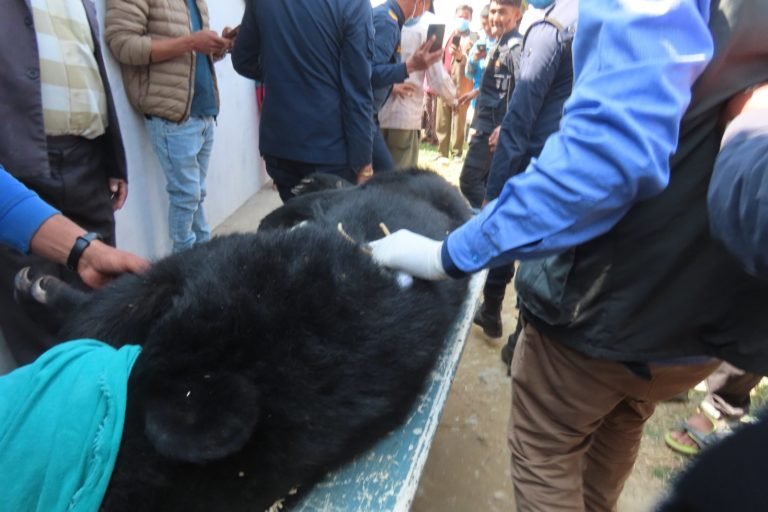- A recent incident of an Asian black bear entering a hospital in eastern Nepal has highlighted the lack of conservation measures for one of the country’s least-understood megafauna.
- The onset of spring coincides with an increase in human-bear encounters, as the animals seek out easy sources of food after their winter hibernation.
- Nepal’s black bear population is estimated at around 1,000, but there’s no consensus on its global population, despite it being a threatened species.
- Already faced with threats from encounters with humans and from demand for bear bile for medicinal use, the animal could also see its range shrink by nearly half due to climate change.
KATHMANDU — A bear walks into a hospital unnoticed at around midnight. It licks bloodstains on the floor. At first, the staffers think it’s a big dog, then realize it’s something else. The hospital is abuzz as people start running outside, yelling, “It’s a bear!”
They call the police, who arrive at the scene and manage to lock the Asian black bear (Ursus thibetanus) inside the hospital’s maternity ward.
News spreads fast around town, and at the crack of dawn, dozens of people wielding DSLR cameras and selfie sticks descend on the hospital for pictures and video of the animal struggling to escape.
A search for “bear in hospital Nepal” on social media returns videos of people narrating the story that started at the Taplejung district hospital in Nepal’s eastern hills on March 3.
Human-bear interactions are common here and other hilly areas across Nepal, where conservationists estimate there may be around 1,000 Asian black bears.
While the more iconic species, such as tigers and rhinos, get all the attention garnered on Nepal’s wildlife, the black bear tends to be overlooked; authorities and communities haven’t come up with concrete plans to conserve this species, especially outside the national parks. It’s the same story in most countries across the bear’s range, where detailed population surveys have never been conducted, despite the species being categorized as threatened on the IUCN Red List.
The global population of Asian black bears has declined by up to 49% over the past 30 years (around three bear generations), according to the IUCN, and could continue on this decline over the next 30 years unless conservation measures are stepped up. The exact global population is a matter of speculation, and incidents like the one in Taplejung are emblematic of the ground-level issues spawned by the lack of conservation management, experts say.
“The Asian black bear faces a host of threats,” says Rabin Kadariya, who recently completed his Ph.D. on the Asian black bear’s distribution in Nepal, focusing on its genetic diversity. “The first threat is that they are killed for their bile [which] is considered to have medicinal properties.”
Bear bile, in some places often drawn directly from the liver of a live caged bear, has long been used in traditional medicine in China, Vietnam and South Korea. Early on in the COVID-19 pandemic, it was being touted by Chinese authorities as a treatment for the coronavirus.
Another threat to the species is human-wildlife conflict, Kadariya says: “As bears live in forests close to human settlements in Nepal, they constantly conflict with humans. When the bears kill domestic animals or attack humans, people go after these bears and often kill them.”
This problem tends to flare up around this time of the year, when the bears, hungry after hibernating throughout the winter, go out in search of food, says Saroj Panthi, who has studied the animal in Nepal’s western hills. “As we have observed that human-bear interactions increase during this period, we could say that the hospital incident took place as the bear was hungry after waking up from hibernation,” he told Mongabay.
Global warming is also likely to impact these bears negatively, according to a study modeling the impact of climate change on Asiatic black bears across Afghanistan, Bangladesh, Bhutan, China, India, Myanmar, Nepal and Pakistan.
Bears currently live at elevations of 1,500-3,000 meters (4,900-9,800 feet) above sea level. If the global temperature increases by 2° Celsius (3.6° Fahrenheit), that range will no longer be suitable as bear habitat, and the animals will have to climb to above 3,500 m (11,500 ft). In Nepal, this would mean a loss of 48% of currently suitable bear habitat.
“The other reasons for loss of habitat could be fluctuations in precipitation and shifting of tree lines towards higher altitudes as the Asiatic black bear is a forest-dwelling species,” the study’s co-author Babar Zahoor told Mongabay.

The incident in Taplejung also suggests local authorities in Nepal are ill-prepared to handle what could become increasingly frequent encounters with bears.
The locked-up bear was finally “discharged” from the hospital after four days. “We found that the local people fed the animal fruits and fish, but for some reason, they didn’t provide water,” said Kiran Raj Rijal, a veterinary technician from the National Trust for Nature Conservation, an NGO. Rijal, whose team sedated the animal, told Mongabay that they had to administer saline water to wake it up, before releasing it in the forest about an hour’s drive from the hospital.
This bear was lucky to survive, but others in the wild may not be as fortunate.
Citation:
Zahoor, B., Liu, X., Kumar, L., Dai, Y., Tripathy, B. R., & Songer, M. (2021). Projected shifts in the distribution range of Asiatic black bear (Ursus thibetanus) in the Hindu Kush Himalaya due to climate change. Ecological Informatics, 63, 101312. doi:10.1016/j.ecoinf.2021.101312
Feedback: Use this form to send a message to the author of this post. If you want to post a public comment, you can do that at the bottom of the page.
Banner Image: Rescuers cage the Asiatic black bear found inside a hospital in eastern Nepal. Photo courtesy Kiran Rijal












